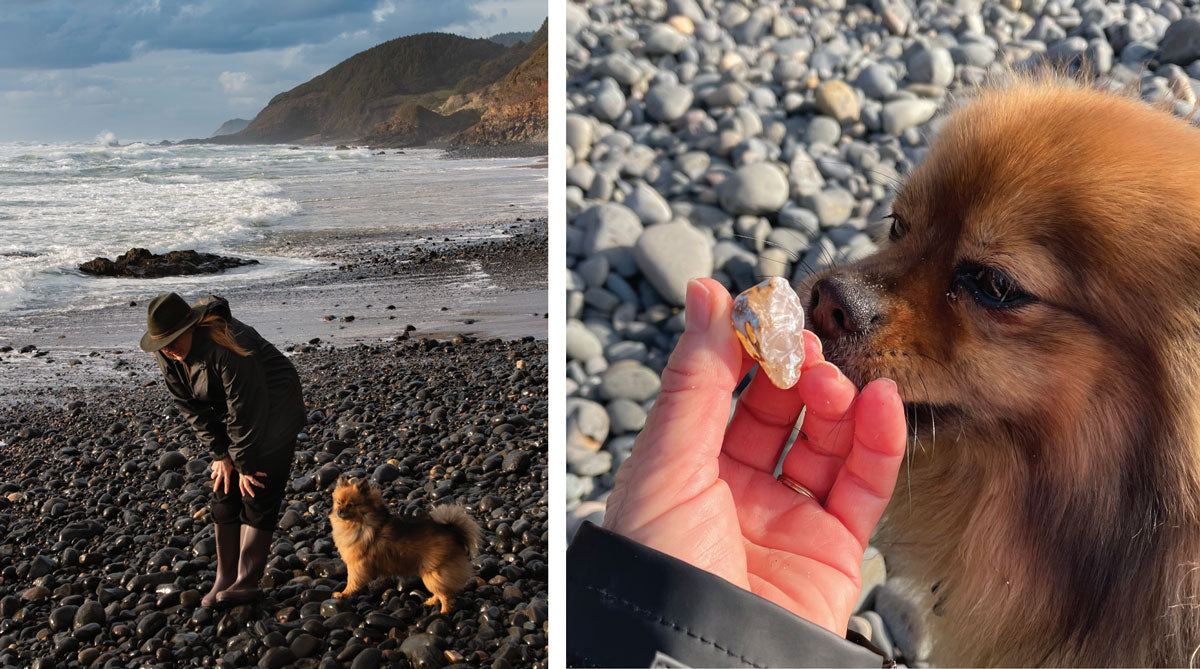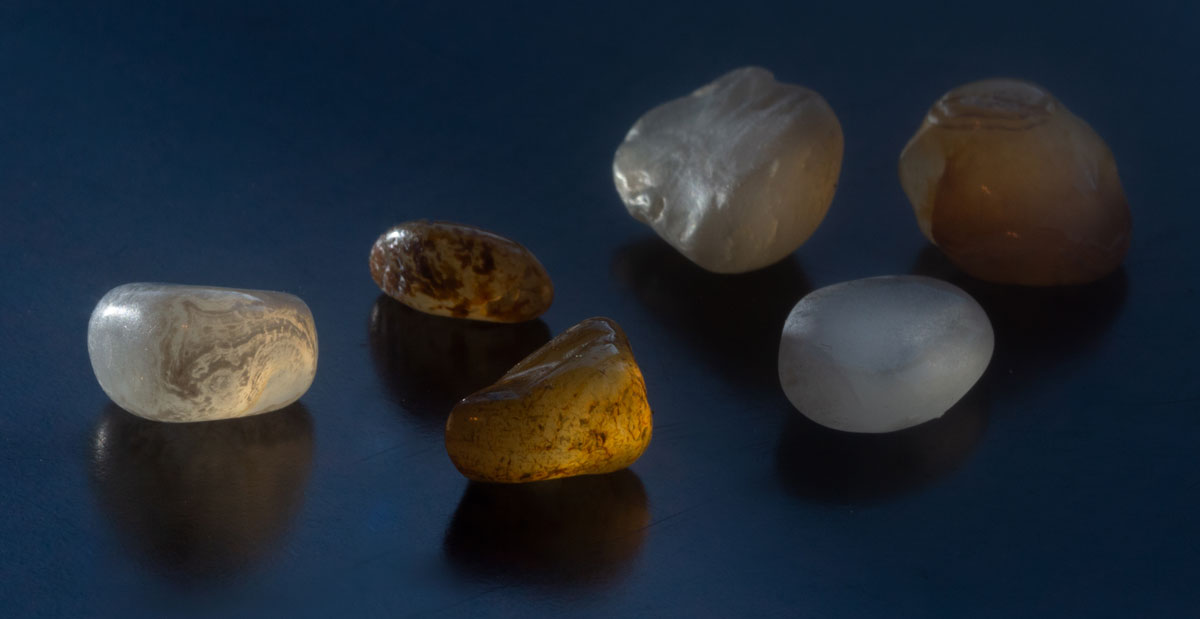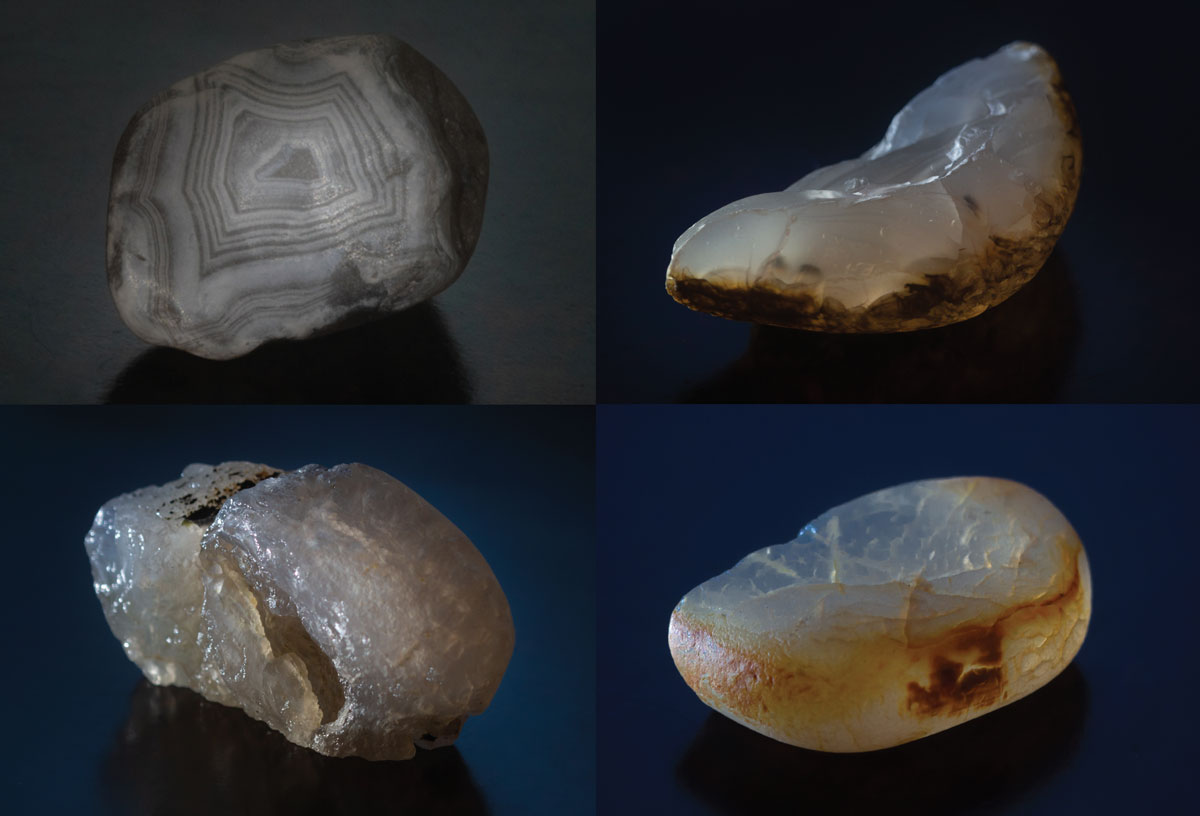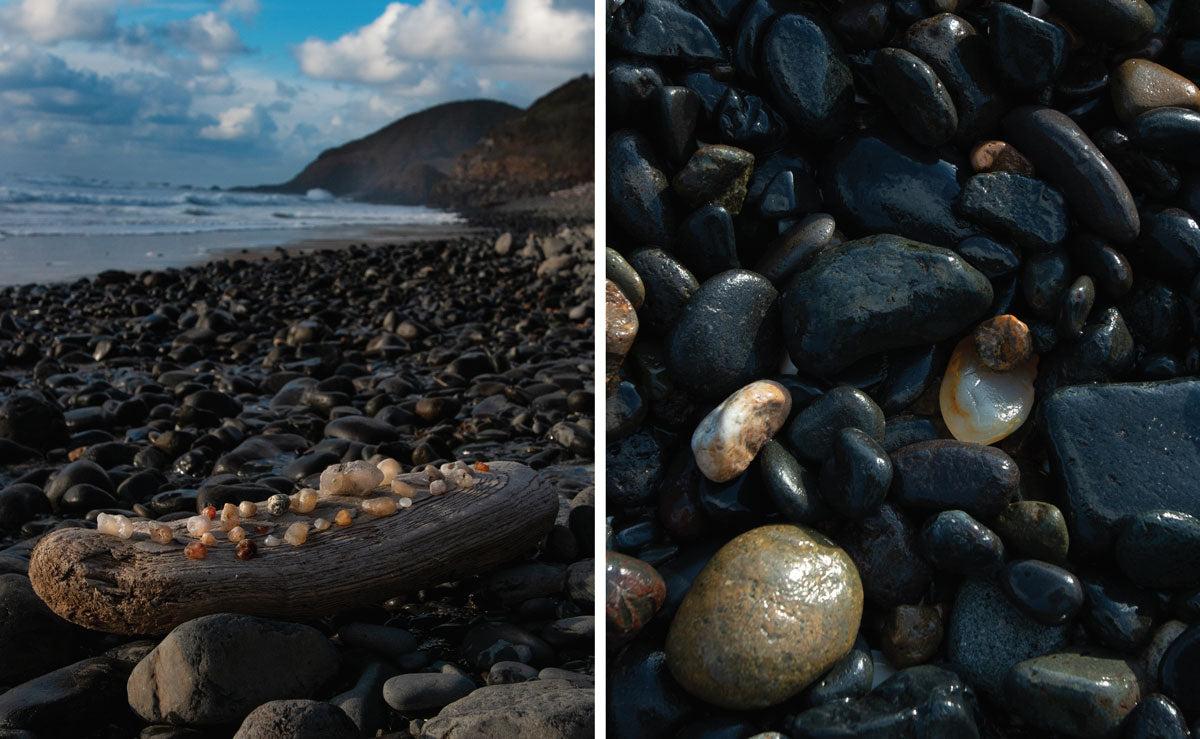Rockhounding the Oregon Coast
By Toby Neal

Rockhounding on the beach in Oregon is no indolent stroll on tropical sand. The stone shoals girding the central coast of the state, battered by the misnamed Pacific Ocean, are rugged in the extreme. The weather, during the season for finding treasures, is seldom friendly. Fall through spring is the time to look for sea-tumbled semi-precious gems, fossils, and petrified wood along Oregon’s stony shores; that’s when the gravel beds (also known as beaches) are exposed by surf and tidal swings from six to ten feet in height daily. Rolling logs and sneaker waves are serious dangers and not to be taken lightly. Any rock hunter must keep a close eye on the ocean and the tides, not just for safety, but to be ready to pounce when a big swell comes through, turning over new pebble fields to forage—and the tides recede to expose their hidden treasures.
I’m a lifelong beachcomber and writer who grew up in Hawaii in the 1970s. On my knees in the bright yellow coral sand of Kauaʻi, I helped my mom search for puka shells, which she made into necklaces to sell to the tourists. I’m someone who’s happiest on a beach, dreamily foraging for anything from driftwood to sea glass.

The Oregon Coast couldn’t be more different from Hawaii, though it shares the Pacific Ocean. Agates, the most popular stone people look for, were unknown to me until our recent move to the state. But once I found one of the glowing, translucent stones, icy and rare as a chunk of frozen milkshake fallen among the slick black basalt, I was hooked.

My first few times rock hunting, I went to a well-known beginner spot with easy access from the highway called Bob’s Creek, near Yachats, Oregon. I found a few chips of clear chalcedony, more commonly known as agate. But even at that relatively safe beach, I turned my ankles in tennis shoes on the rolling beach stones and was soon soaked by rain and a rogue wave. The temperatures were never warmer than the 40s, and holding an umbrella was impossible with gusting wind—and pro tip: once wet, the activity becomes downright unpleasant.
My husband Mike and I then investigated how the more serious beachcombers we saw were outfitted. These rockhounds dressed in head-to-toe rubber raingear and heavy wellington boots. The boots served multiple purposes of being able to look for rocks in the creeks or surf and keeping feet warm and protected. These hardy folks were of equal gender distribution, and this was the first time I shared my beachcombing obsession with my husband. Many of the male rockhounds wore camouflage rain fatigues; I joked to Mike that they were sneaking up on the rocks, but he offered the more prosaic explanation that they probably also used their outerwear for hunting. As a newbie to Oregon, that hadn’t crossed my mind!

I now dress in layers, as I’m likely to encounter a full range of weather on any given day: first, a pair of fleece-lined nylon pants with hip waders that come to mid-thigh, attached to a belt worn just for that purpose. On my torso, a turtleneck and then a thin down coat; on top of everything, a rubber rain slicker with a hood. I wear neoprene gloves with the fingers cut off and a felted wool all-season “outback” hat that fits under my rain hood. In my pockets, I carry a bag for my finds, a metal spaghetti scooper for digging with, and a high-intensity flashlight. I also never go out without at least three pairs of socks to pad and insulate my feet. The rocky shore can be very unkind, even in heavy boots.
Mike and I joined several online groups to learn more about our new sport/hobby/obsession, but the best things we have learned about agate hunting the Oregon Coast has not been from groups, blogs, or books, but our own experimentation and observation.
After several expeditions in a variety of tidal times, we speculated that going out on a receding tide would be better than a low tide, because we would be among first to capture the gems as they were uncovered by the turbulent sea. This turned out to be accurate; we beat the crowds to be the first to search (crowds in Oregon being two or three other people).
The next thing we observed was that, for agates to show up against their darker, denser cousins, a light source was helpful. We figured this out simply by comparing how many more interesting stones we found on sunny days than on overcast ones, even on the same beach in similar conditions, hence the addition of a flashlight for dim and shady areas.
Agates are transparent and rougher (at least on Oregon’s central coast) than the surrounding other rocks because of their crystalline, high-density structure. They take double or triple the time to wear down than other rocks. They also fade into obscurity until light hits them; then they come to life and beg to be picked up, bits of jagged moonlight floating on a night sky.
I’ve spent some time considering why I’ve become increasingly obsessed with rock hunting, in spite of its many challenges.
Intermittent reinforcement. The fact that sometimes you “find a good one” and many times you don’t, leads to a greater sense of payoff in agate hunting. It wouldn’t be as rewarding if it was easy, or if the stones were plentiful.
I’ve always loved gems and jewels. As a kid and the oldest of my siblings, I invented a game that we played for years called “jewel thieves.” Jewel Thieves was a variation on Capture the Flag. We used our grandmother’s discarded, broken costume jewelry to create boxes of “treasure” that teams had to try to find and steal from each other. Dress up, acting, and strategy were a part of it, and that love of sparkly things, paired with my childhood growing up on the beaches of Hawaii, led me to become a jewelry and glass bead maker in the 1990s. Though I left that behind, the ‘rock lust’ remains.
Rock lust in a great setting. There’s just nothing like being able to walk along an empty beach with my husband and dog, the rush of waves in my ears, looking for semi-precious jewels (carnelian, garnet, sardonyx, jasper, bloodstone, jade, and moonstone—as well as fossils and petrified wood) among the pebbles of the shore as the seagulls cry and seals swim. The stark beauty of the rugged coast, when properly dressed, is downright captivating.
An ideal rockhounding day is a receding tide on a non-sandy shoreline after an extra high tide with big surf the day before, and sun coming through to hit the beach. No matter where you are on the central Oregon coast, in those conditions you are virtually guaranteed to find some fabulous semi-precious stones to take home.
Read about Toby’s childhood in Hawaii in the 1970s in her book FRECKLED: A Memoir of Growing up Wild in Hawaii.
All photos by Mike Neal. Find Mike on Facebook @MikeRNeal.
Learn more about beach rocks:

Learn more about beach rocks including agates, Cape May diamonds, Yooperlites, fulgurite, puddingstone, and more. Articles ›
This article appeared in the Beachcombing Magazine July/August 2023 issue.
1 comment
It’s Bob Creek, not Bob’s Creek.
Crowds showing up early at our popular agate hunting destinations often include 15-20 others. Expect more on sunny days and weekends.
Not all agates on Oregon’s central coast are rougher. It depends on the beach. Many of my agates look tumbled, upon discovery.
Enjoyed the article.
A lifetime Oregon Coastie






